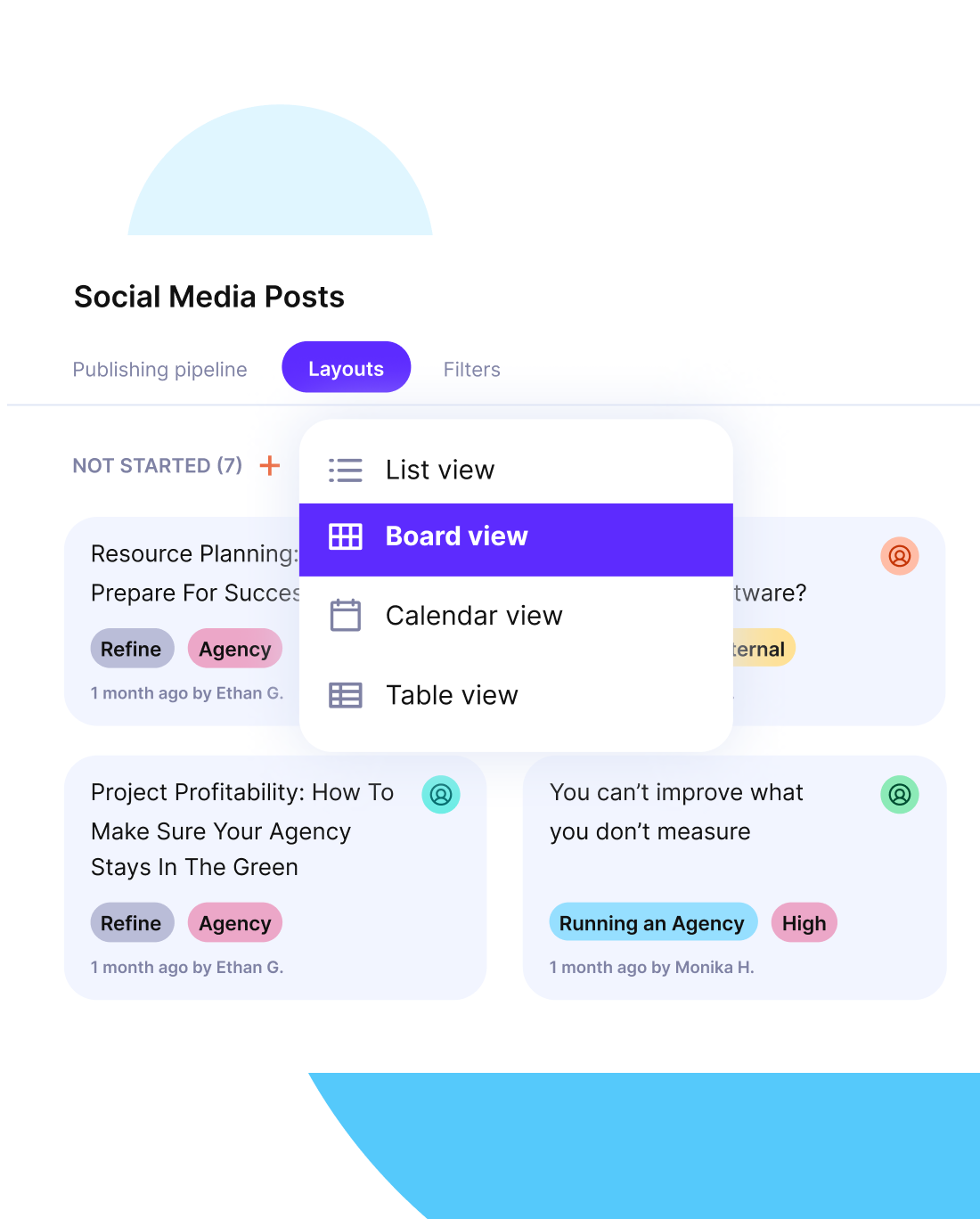What Is Team Performance + How To Measure and Improve It
In case you’re struggling with low team performance and morale, you’ve come to the right place.
This guide will teach you how to measure and improve team performance. You’ll also learn about the best practices, common challenges, and how to avoid employee burnout.
Key Takeaways
- Avoid social loafing by giving every team member visible ownership of deliverables, making individual contributions clear and accountable.
- Track performance with simple metrics that connect objectives to project management progress, so leaders see results beyond effort.
- Adapt workloads and objectives regularly to prevent burnout, balance capacity, and keep overall performance steady across teams.
- Strengthen hybrid teams by using clear rituals and shared tools that maintain alignment, build trust, and keep visibility high.
What Is Team Performance?
Team performance is the combined output and health of a team as it works toward objectives. It measures not just results but also how teams collaborate with trust and culture. So it reflects both the quality of deliverables and the way people work together.
Weak team performance shows when individuals succeed alone, but the collective effort fails to meet goals.
Next, healthy team dynamics blends clear project objectives with shared responsibility, so the whole team delivers consistently. You can get there by checking both outcomes and behaviors, not only task completion.
For a basic example, one designer finishing early means little if the rest of the team cannot launch on time.
Why Is Team Performance Important?
Team performance matters because it drives delivery quality, retention, and client trust. Strong performance improves organizational and workforce performance together.
Low team performance slows delivery, raises burnout risk, and weakens morale. For project-based teams, wasted hours fixing miscommunication replace billable hours spent delivering client work.
That hurts both revenue and reputation.
You address this by investing in clear goal achievements, healthy collaboration, and fair workload planning. Leaders who track these areas create better delivery, less burnout, and higher retention.
What Factors Drive High-Performing Teams?
The major drivers of team performance are objectives, roles, culture, and leadership. All of them matter because companies (and projects) depend on consistent delivery and morale to retain clients and staff.
You build stronger performance by setting measurable objectives, clarifying each role in kickoff sessions, reinforcing positive culture, and modeling healthy leadership habits.
- Clear objectives align effort with business goals and help team members prioritize work.
- Strong roles prevent confusion by giving every member ownership of outcomes.
- Team culture shapes behaviors, builds trust, and reduces conflict, so collaboration feels natural.
- Effective leadership connects all these elements, guiding teams through change and keeping focus on results.
What Are the Common Team Performance Pitfalls? + (How To Avoid Them)
The biggest risks to team performance are social loafing, misaligned goals, and overload. Each reduces results and damages morale.
When teams face these pitfalls, delivery slows and frustration grows. Even high skill cannot compensate for poor team dynamics or a lack of clear goals.
You reduce the risks by naming them, setting preventive steps, and making owners accountable for fixes. Below, we’ll teach you how to do exactly that.

How Do You Prevent Social Loafing?
Social loafing happens when some team members reduce effort, expecting others to cover their share. It emerges from weak accountability and unclear expectations.
That is a big problem because it drags down collective performance and encourages negative team behaviors.
You prevent it by keeping groups smaller, assigning visible tasks, and making ownership public. Set individual deliverables with clear owners, then track progress in a shared space. This increases accountability and removes cover for disengagement.
In big projects with huge teams, you can cut loafing by breaking work into smaller streams, each with a named lead who updates progress weekly.
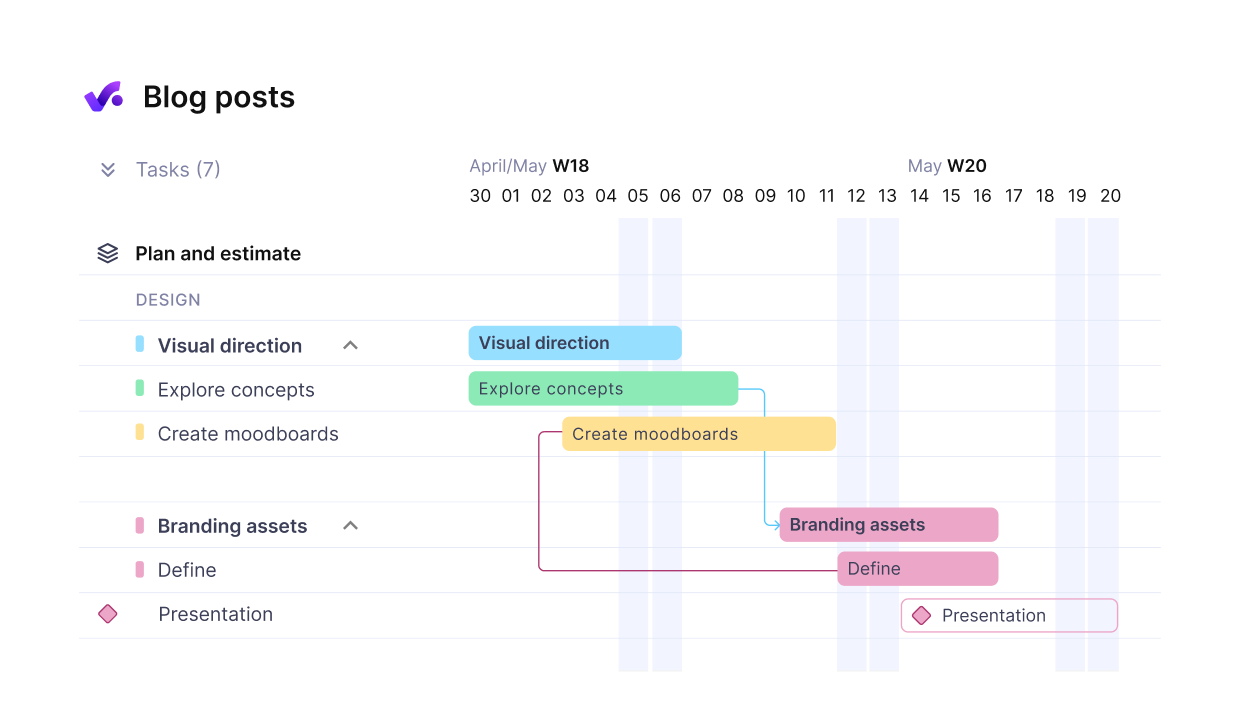
Break up work into smaller dependent tasks.
How Do You Fix Misaligned Goals?
Misaligned goals occur when team objectives and key results are vague, conflicting, or poorly communicated. This confusion weakens team health and undermines trust. When objectives pull in different directions, team members work hard, but results remain inconsistent.
Unclear priorities waste capacity and strain relationships.
You fix misalignment by setting shared objectives and aligning them with both team and individual goals. Leaders should clarify priorities at kickoff and repeat them in weekly check-ins.
Objectives must be visible, measurable, and connected to broader outcomes.

Add objectives as tasks and milestones with clear owners and descriptions.
How Do You Manage Overload and Burnout?
Overload occurs when individuals are stretched too thin, while others disengage. This imbalance weakens delivery and hurts morale.
That matters because overworked staff burn out while idle teammates lose motivation.
You solve overload with capacity planning and a simple performance plan that balances workloads fairly. Assign tasks based on actual availability, not wishful estimates. Rotate responsibility to avoid repeating strain on the same individuals.
Leaders should manage workloads and review them weekly to redistribute work before pressure escalates.
This pitfall is super common in the digital agency industry. Agencies should use capacity planning tools to see who has space for new work and reduce overtime.
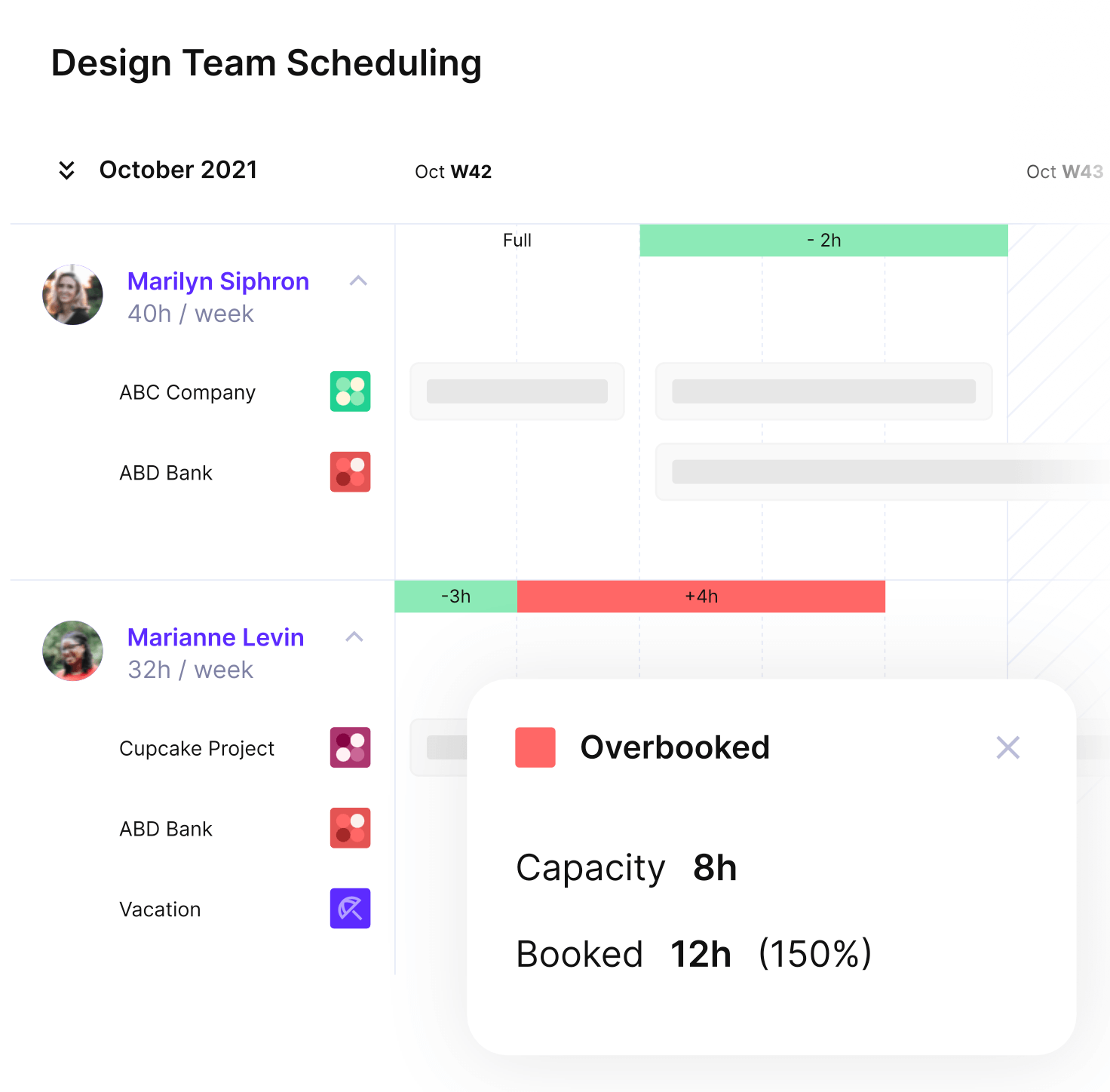
Use Productive to spot and prevent overbooking.
How To Measure and Improve Team Performance? (Step-by-Step Process)
You measure and improve team performance by setting clear goals, tracking simple metrics, and running tight feedback loops. In practice, this means defining goals that link directly to client outcomes, turning them into trackable tasks, and reviewing progress on a set rhythm.
It also means checking team health regularly and closing the loop by turning lessons into concrete actions. Below, we’ll break up the process in six easy-to-follow steps with owners and outcomes so you can apply them directly.
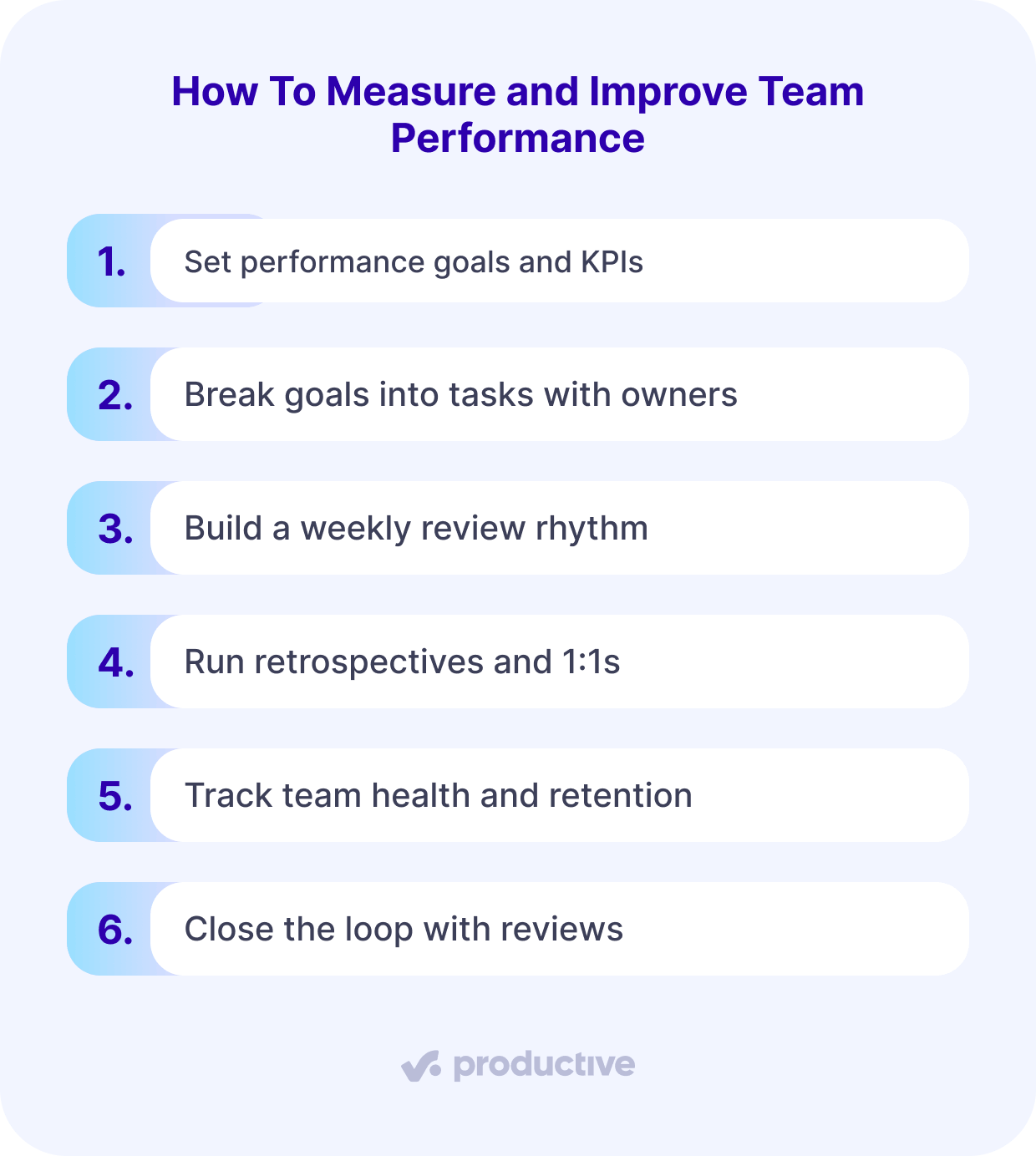
Step 1: Set performance goals and KPIs
Setting performance goals and KPIs gives the team a clear target. This practice matters because without shared goals, effort scatters and impact is hard to measure.
Strong goals link directly to client deliverables or revenue, so the team sees why they matter. KPIs like on-time task completion, cycle time, and satisfaction scores make progress measurable.
How to implement:
Define two or three goals for the quarter. Write them down in a shared dashboard like Productive and review them weekly. Tie each goal to a client or business outcome. Assign a project lead as the owner.
- Owner: project lead
- Outcome: every team member understands what success looks like and can track progress in real time

Get a real-time overview of project progress against key metrics.
Step 2: Break goals into tasks with owners
Breaking goals into smaller tasks makes progress manageable and transparent. This practice matters because without clear ownership, tasks slip and accountability fades. Teams lose sight of who owns what, and delivery slows.
How to implement:
Split each goal into specific tasks with one clear owner. Publish them on a visible board like Asana or Productive so everyone can see the status. Never leave tasks unassigned. Review the board daily and flag blocked items immediately.
- Owner: delivery manager
- Outcome: every task has a visible owner, and progress is clear to the whole team
Step 3: Build a weekly review rhythm
Weekly reviews create a fixed rhythm to check progress and stop problems from growing. They matter because without regular reviews, blockers pile up and delivery drifts off track.
A short, focused review keeps performance teams aligned and accountable.
How to implement:
Schedule a 30-minute weekly review dedicated only to performance goals. Walk through each goal, confirm what has moved forward, and discuss why tasks slipped. Record follow-ups as dated actions in your task board.
Assign clear owners for each action and check them at the next review.
- Owner: team lead
- Outcome: blockers resolved quickly, and delivery momentum was maintained
Step 4: Run retrospectives and 1:1s
Retrospectives are structured sessions where the team reflects on delivery and extracts lessons. They matter because they surface recurring issues, encourage openness, and create a cycle of continuous improvement.
Without retros, teams risk repeating the same mistakes and missing opportunities to improve collaboration.
How to implement:
At each milestone, hold a 45-minute retro. Summarize what went well, what failed, and what to adjust. Turn two improvements into action items with clear owners and deadlines. Track these in a dashboard like Productive, so progress is visible to all.
Use 1:1s alongside retros to dig into workload or performance gaps privately.
- Owner: team lead
- Outcome: continuous improvement linked to actions that are tracked and delivered.
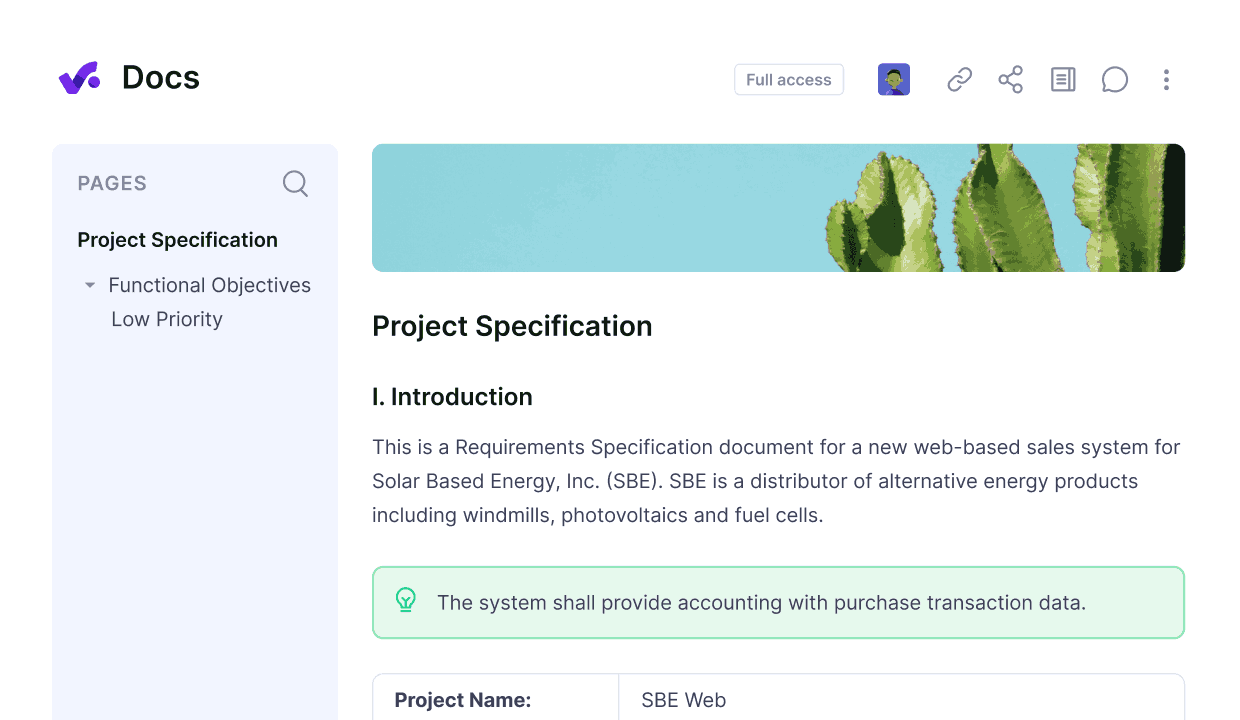
Document retro reviews, risks and milestone summaries in Productive.
Step 5: Track team health and retention
Tracking team health and retention ensures that delivery is sustainable. This practice matters because burnout and turnover quietly erode performance before leaders notice. Without regular checks, teams push too hard until people quit or quality slips.
How to implement:
Send a short and simple two‑question pulse survey each month:
- How sustainable is your workload?
- How do you feel about your workload?
Review the results in a team meeting and adjust assignments if scores drop.
Pair feedback and surveys with data from dashboards like Productive to spot overtime, unused vacation, or recurring late nights. Act quickly by redistributing tasks or adding support where needed.
- Owner: people lead
- Outcome: steady delivery with fewer surprises and healthier teams
We talk more about team dynamics, improving communications and accountability in our remote team management guide.
Step 6: Close the loop with reviews
Closing the loop turns insights from reviews and retros into real change. This practice matters because without follow‑through, teams repeat the same issues and lose trust in the process. Actions need to stay visible until they are completed.
How to implement:
Add retro and review actions to the team board with clear owners and due dates. Bring them up in every weekly review until complete. If items are overdue, escalate them in leadership check‑ins so accountability stays high.
- Owner: project lead
- Outcome: improvements tracked, finished, and embedded into daily work
Track and improve performance with Productive
How Does Team Performance Change in Remote and Hybrid Settings?
You measure how team performance changes in remote and hybrid settings by looking at visibility, communication, and engagement. Remote teams lose the informal updates that happen in offices, so leaders must replace them with structured rituals.
That matters because without visibility, effective teams drift and high-performing teams struggle to stay aligned.
You improve visibility by running async daily updates where each member posts progress and blockers. This keeps work transparent without adding long meetings. Communication also needs structure: set rules for response times and channels so messages don’t get lost.
You can get more actionable advice and how-tos in our communication plan guide.
Keeping engagement high is tougher remotely because casual office chats disappear, and trust must be built deliberately. Leaders should run monthly check-ins focused on workload and morale, not only tasks.
Use shared dashboards to show progress and celebrate wins in one place. For more detailed practices, see our remote working guide. It explains how to keep employee engagement high and sustain performance when teams are spread out.
What Are the Best Practices for Continuous Team Improvement? (+ How To Implement Them)
The best practices for improving team performance are retrospectives, check-ins, and capacity reviews. These habits build consistency over time and help teams adapt quickly.
Next, we’ll expand each practice with clear steps you can apply.
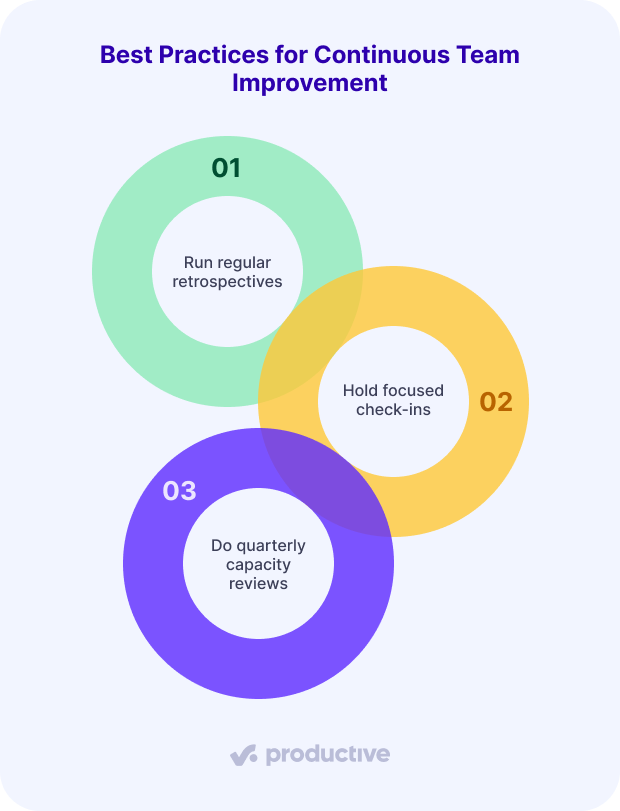
Best Practice 1: Run regular retrospectives
A retrospective is a short session where the team reflects on recent delivery and uncovers lessons. Retros matter because they build an effective team culture of openness and continuous learning.
When run consistently, they help performance teams spot patterns, reduce repeated mistakes, and improve collaboration.
How to implement:
Schedule a 45-minute retro at the end of each sprint or milestone. Summarize what worked well, note what failed, and agree on one or two changes to try next. Capture these insights directly in a dashboard like Productive so progress is visible and tracked across the team.
Write down two improvements (like less resource constraints due to new allocations and shorter review cycles due to better task briefs), assign clear owners, and set deadlines.
Bring these items back in the next retro to confirm they were completed. For example, a dev agency cut release delays by half after turning each retro insight into a tracked action in their workflow.
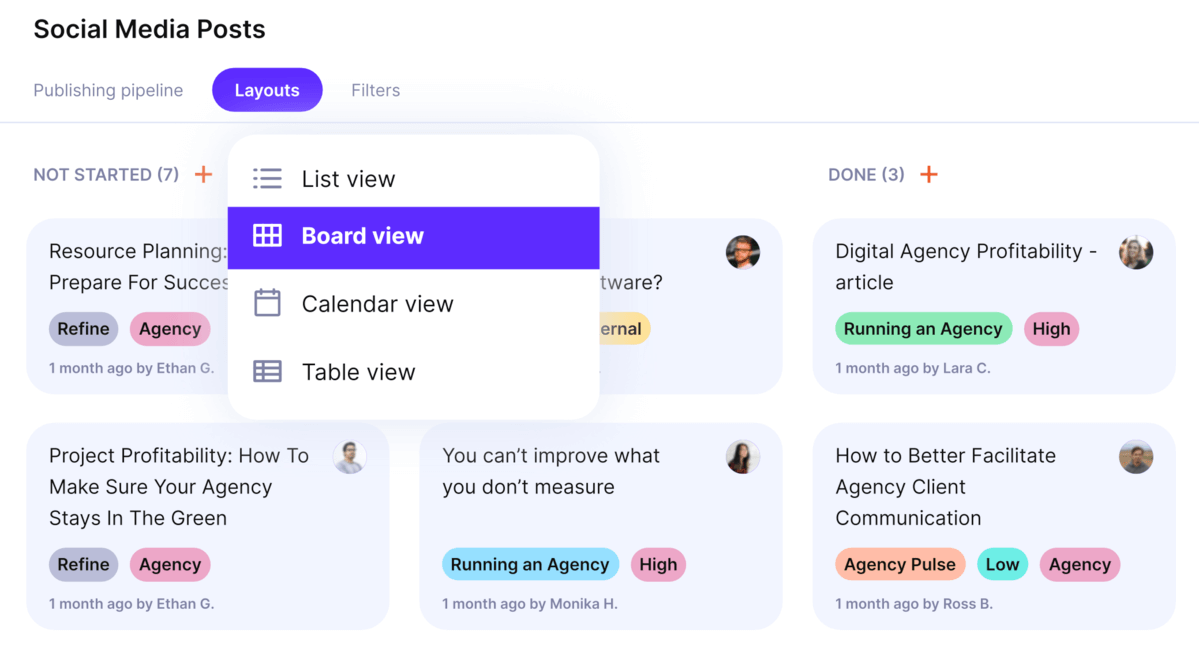
Use Productive’s Kanban boards for managing retros and sprints.
Best Practice 2: Hold focused check-ins
Check-ins are short, regular conversations that keep performance teams aligned between milestones. They matter because without them, issues linger until they escalate into real delivery risks.
A good check-in also strengthens trust and makes workload problems visible early.
How to implement:
Hold a 15-minute weekly check-in with each member. Cover three topics: current workload, risks, and support needed. Note actions in a shared dashboard like Productive, so progress is visible to everyone. Make sure each risk has an owner and a deadline.
For example, a dev agency avoided major scope creep by flagging small requirement changes during check-ins. By logging these early, they kept projects on track and clients informed.
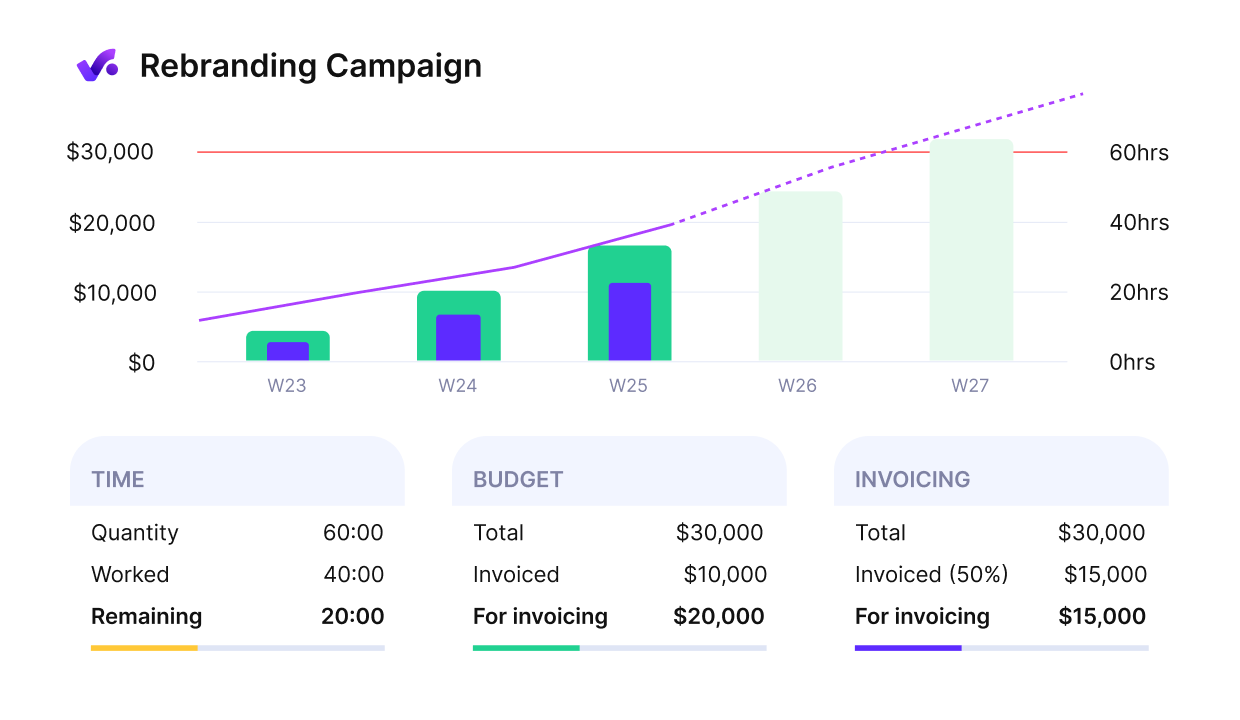
Productive gives you an early warning of budget overruns.
Best Practice 3: Do quarterly capacity reviews
Capacity reviews are structured checks to see if planned workloads match actual hours delivered. They matter because overload damages delivery and morale, while underuse wastes capacity.
When ignored, both issues lead to missed deadlines and unhappy clients.
How to implement:
Once a quarter, compare estimated hours to actuals for each team member. Use a dashboard in Productive to visualize workload distribution. Reassign tasks where individuals are overbooked and note who has free capacity.
Discuss findings openly in a team session so adjustments feel transparent.
For example, a dev agency reduced overtime by 40% after running quarterly capacity reviews. They spotted consistent overbooking among their senior developers and redistributed work, which improved balance and delivery speed.
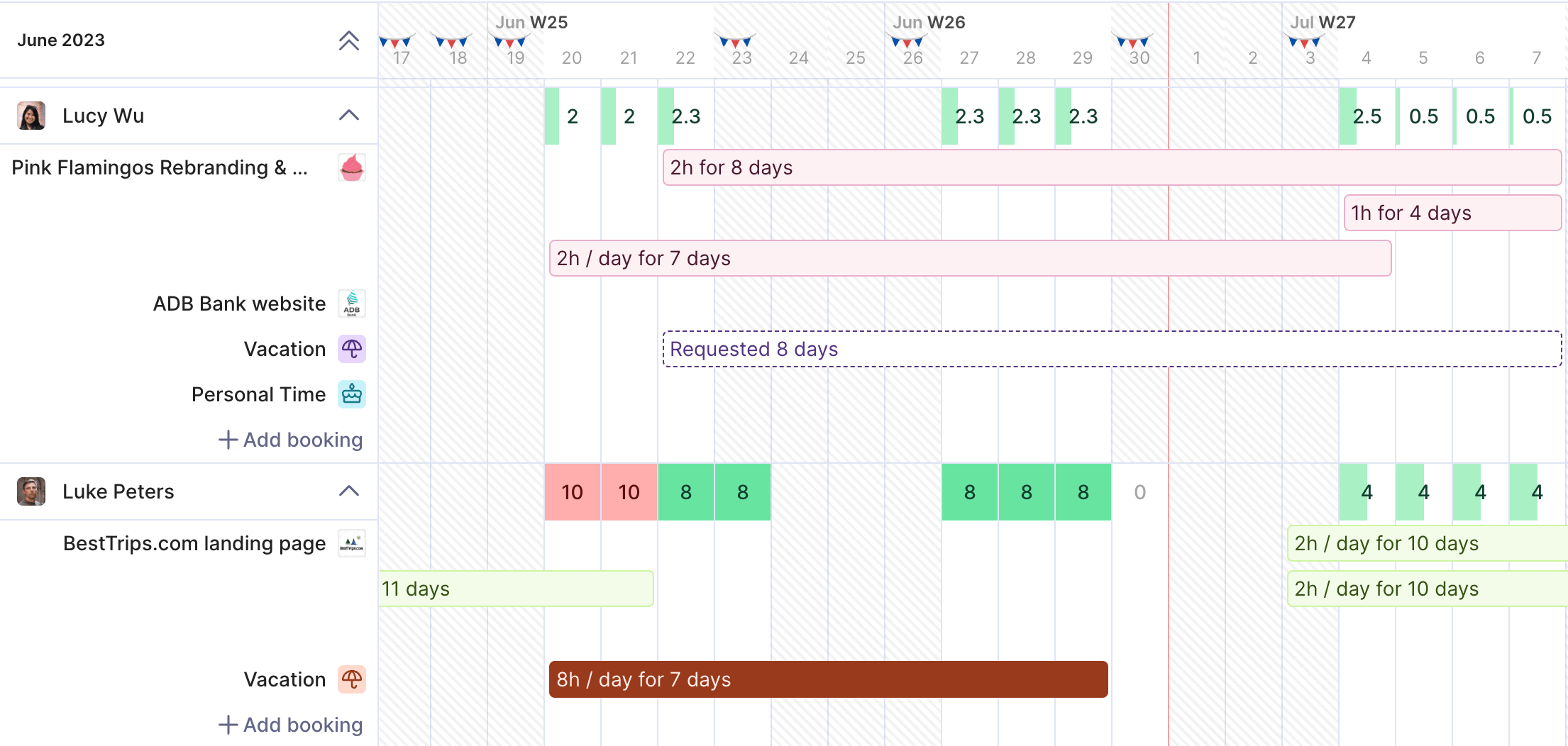
Track your resources and plan your team’s workloads in Productive.
How Can You Apply These Insights to Your Team?
The best way to apply these insights is to start small and stay consistent. Pick one area, such as goals, visibility, or workload, and improve it deliberately. That focus matters because scattered efforts rarely stick, while one concrete change shifts how a team works.
Begin with clear goals. Write them down, link them to client outcomes, and share them in your dashboard. Next, make progress visible with simple metrics so the team knows where they stand.
Finally, review workload balance regularly to protect morale and delivery.
All of these steps are super simple, but together they compound into lasting success.
If you want a technology tool that makes these steps easier, try Productive. It connects goals, tasks, and dashboards in one place, so you spend less time chasing updates and more time coaching.
Book a demo to see how it supports better team performance in practice.
Fix Underperformance with Real Data
Identify blockers early, track overdue tasks, and keep teams accountable with real-time progress views in Productive.
